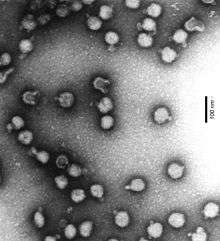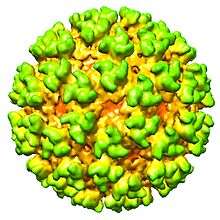Semliki Forest virus
| Semliki Forest virus | |
|---|---|
 | |
| Virus classification | |
| Group: | Group IV ((+)ssRNA) |
| Family: | Togaviridae |
| Genus: | Alphavirus |
| Species: | Semliki Forest virus |

The Semliki Forest virus was first isolated from mosquitoes in the Semliki Forest, Uganda by the Uganda Virus Research Institute in 1942 and described by Smithburn & Haddow.[2] It is known to cause disease in animals including humans. It is an Alphavirus found in central, eastern, and southern Africa.
The Semliki Forest virus is a positive-stranded RNA virus with a genome of approximately 13,000 base pairs which encodes nine proteins.[3] The 5’ two thirds of the genome encode four non-structural proteins concerned with RNA synthesis and the structural proteins are encoded in the 3’ third. Of the structural proteins, the C proteins makes up the icosahedral capsid which is enveloped by a lipid bilayer, derived from the host cell. The outermost surface of the virus is almost entirely covered by heterodimers of glycoproteins E1 and E2, arranged in interconnective trimers, which form an outer shell. Trimers are anchored in the membrane by an E2 cytoplasmic domain that associates with the nucleocapsid.
Replication occurs via a negative strand intermediate giving rise to a full length genomic RNA for export in new virions and a subgenomic message that is translated into the structural proteins.
Semliki Forest virus is spread mainly by mosquito bites. It is not able to infect mammals through inhalation or gastrointestinal exposure, although rodents in the laboratory can be infected by intranasal instillation. The virus is able to cause a lethal encephalitis in rodents,[4] but generally only mild symptoms in humans.[5] Only one lethal human infection has been reported. In this one case, the patient was speculated to be immunodeficient and potentially had been exposed to large amounts of virus in the laboratory.[6]
Semliki Forest virus has been used extensively in biological research as a model of the viral life cycle and of viral neuropathy. Due to its broad host range and efficient replication, it has also been developed as a vector for genes encoding vaccines and anti-cancer agents,[7] and as a tool in gene therapy.[8]
Since Semliki Forest virus naturally infects cells of the central nervous system it has been pre-clinically tested as an oncolytic virus against the severe brain tumour type glioblastoma. The SFV virus was genetically modified with microRNA target sequences so that it only replicated in brain tumour cells and not in normal brain cells. The modified virus reduced tumour growth and prolonged survival of mice with brain tumours.[9] The modified virus was also found to efficiently kill human glioblastoma tumour cell lines.[10]
See also
References
- ↑ Mancini, E. J.; Clarke, M.; Gowen, B. E.; Rutten, T.; Fuller, S. D. (2000). "Cryo-electron microscopy reveals the functional organization of an enveloped virus, Semliki Forest virus". Molecular Cell. 5 (2): 255–266. doi:10.1016/S1097-2765(00)80421-9. PMID 10882067.
- ↑ Smithburn, KC; Haddow, AJ (1944). "Semliki Forest Virus I. Isolation and Pathogenic Properties". J. Immunol. 49: 141–157.
- ↑ Atkins, G. J.; Sheahan, B. J.; Liljeström, P. (1999). "The molecular pathogenesis of Semliki Forest virus: A model virus made useful?". The Journal of general virology. 80 (9): 2287–2297. doi:10.1099/0022-1317-80-9-2287. PMID 10501479.
- ↑ Atkins, G. J.; Sheahan, B. J.; Dimmock, N. J. (1985). "Semliki Forest virus infection of mice: A model for genetic and molecular analysis of viral pathogenicity". The Journal of general virology. 66 (3): 395–408. doi:10.1099/0022-1317-66-3-395. PMID 2982998.
- ↑ Mathiot, C. C.; Grimaud, G.; Garry, P.; Bouquety, J. C.; Mada, A.; Daguisy, A. M.; Georges, A. J. (1990). "An outbreak of human Semliki Forest virus infections in Central African Republic". The American journal of tropical medicine and hygiene. 42 (4): 386–393. PMID 2158754.
- ↑ Willems, W. R.; Kaluza, G.; Boschek, C. B.; Bauer, H.; Hager, H.; Schütz, H. J.; Feistner, H. (1979). "Semliki forest virus: Cause of a fatal case of human encephalitis". Science. 203 (4385): 1127–1129. doi:10.1126/science.424742. PMID 424742.
- ↑ Quetglas, J. I.; Ruiz-Guillen, M.; Aranda, A.; Casales, E.; Bezunartea, J.; Smerdou, C. (2010). "Alphavirus vectors for cancer therapy". Virus Research. 153 (2): 179–196. doi:10.1016/j.virusres.2010.07.027. PMID 20692305.
- ↑ Lundstrom, K. (2003). "Semliki Forest virus vectors for gene therapy". Expert Opinion on Biological Therapy. 3 (5): 771–777. doi:10.1517/14712598.3.5.771. PMID 12880377.
- ↑ Ramachandran, Mohanraj; Yu, Di; Dyczynski, Matheus; Baskaran, Sathishkumar; Zhang, Lei; Saul, Sirle; Lulla, Aleksei; Lulla, Valeria; Nelander, Sven (2016-01-01). "Safe and effective treatment of experimental neuroblastoma and glioblastoma using systemically administered triple microRNA-detargeted oncolytic Semliki Forest virus". Clinical Cancer Research: clincanres.0925.2016. doi:10.1158/1078-0432.CCR-16-0925. ISSN 1078-0432. PMID 27637889.
- ↑ Ramachandran, Mohanraj; Yu, Di; Dyczynski, Matheus; Baskaran, Sathishkumar; Zhang, Lei; Saul, Sirle; Lulla, Aleksei; Lulla, Valeria; Nelander, Sven (2016-01-01). "Safe and effective treatment of experimental neuroblastoma and glioblastoma using systemically administered triple microRNA-detargeted oncolytic Semliki Forest virus". Clinical Cancer Research: clincanres.0925.2016. doi:10.1158/1078-0432.CCR-16-0925. ISSN 1078-0432. PMID 27637889.
- Gomez De Cedrón, M.; Ehsani, N.; Mikkola, M. L.; García, J. A.; Kääriäinen, L. (1999). "RNA helicase activity of Semliki Forest virus replicase protein NSP2". FEBS Letters. 448 (1): 19–22. doi:10.1016/S0014-5793(99)00321-X. PMID 10217401.
- Hardy, P. A.; Mazzini, M. J.; Schweitzer, C.; Lundstrom, K.; Glode, L. M. (2000). "Recombinant Semliki forest virus infects and kills human prostate cancer cell lines and prostatic duct epithelial cells ex vivo". International journal of molecular medicine. 5 (3): 241–245. doi:10.3892/ijmm.5.3.241. PMID 10677563.